Reciprocating saws have lots of applications in the construction industry. That’s because it can be used to cut just about anything on the jobsite like wood, plastic, epoxy, metal, concrete and so on.
That’s why it’s mainly used for construction and demolition work, because it can cut about any type of building material, provided it has the right blade installed.
Its cutting action results from the fast to-and-fro motion of the cutting blade. Reciprocating saw blades come in different lengths from 3 inches to 13 inches, and the saws itself also come in different length and sizes.
Shorter blades are more rigid and aggressive and thus ideal for straighter cuts like when making plunge cuts and cutting harder materials like metal.
Longer blades are more flexible, and thus are better for making flush cuts since the blade can bend flush with the material. They’re better for pruning tree branches, demolitions, auto-dismantling and so on. This is because they dissipate more heat as a result of the larger surface area used during the cut.
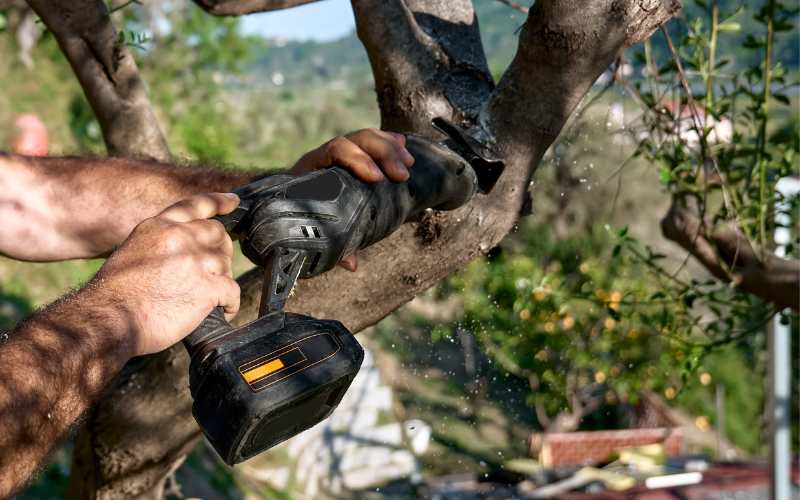
Apart from the type of blade, the amps rating of a reciprocating saw also determines how powerful it is. The more Amps, the more power and aggressiveness through cuts.
Table of Contents
How to choose a reciprocating saw
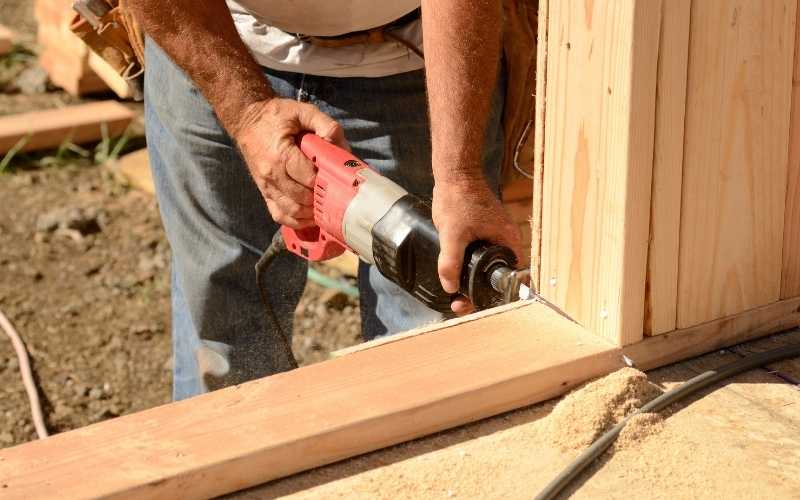
If you’re trying to purchase a new reciprocating saw, there are few factors you need to consider before you choose anyone, especially if it’s your first time of owning one.
Read through carefully in order to make the best decision.
Corded Vs Cordless Reciprocating Saw
When choosing your first reciprocating saw, the first decision you have to make is whether you want a corded or a cordless one.
Obviously, a corded one is one with an extension cord for connecting it to a power source, while a cordless one is one that uses batteries.
The decision to choose either one of them will depend on the type of work you want to do, where you want the job done and how long you will be doing the job. Though, it will largely depend on the latter two.
A cordless reciprocating saw will allow you the freedom to get work done anywhere. It is the option you need when you don’t have access to a power outlet.
For example, in a remote jobsite where you don’t have access to electricity or even around your home, when you want to prune some trees in the garden, a cordless unit is your best bet.
Normally, when you talk about a cordless tool, most people usually associate it with less power and less run time because of limited battery power.
However, recent technological advancements in the motors used in cordless tools and batteries have leveled the playing field to some extent.
For instance, manufacturers now use brushless motors which are more energy efficient. Coupled with that, innovations in batteries such as the Dewalt Flexvolt Battery Technology has totally revolutionized how batteries integrate with tools, and made it possible to get more run time from cordless tools.
So on this note, if your work will take you where there is no electricity, don’t be afraid to invest on a cordless tool.
On the other hand, if you will have continuous access to electricity, then by all means, get a corded reciprocating saw. Then, there is no need to get a cordless one.
Motor / Power
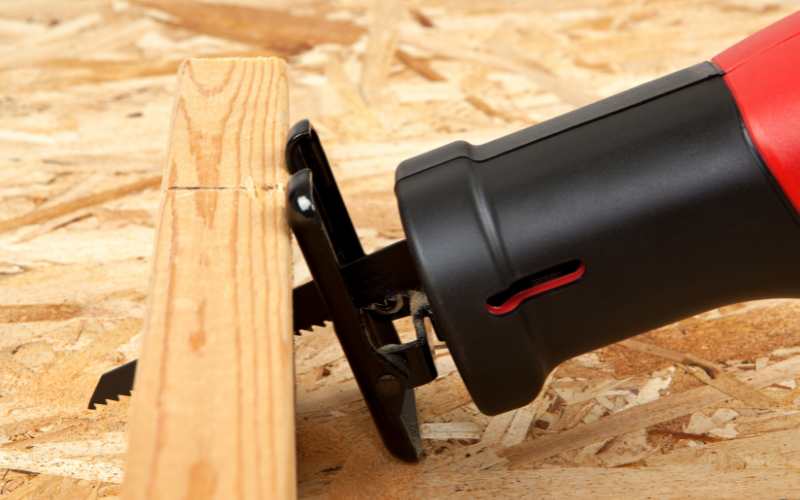
When shopping for a cordless reciprocating saw, you’re going to come across several amp ratings on these saws.
You must note this because, it is very important. The greater the amp, the tougher the work it can do. So, you are going to see 7.5 amps, 9, 10, 11, 12, 13 up to 15 amps.
For light-duty tasks around the home, you can get a 7.5 to 10 amps reciprocating saw, depending on how light-duty the task is.
Task such as pruning little trees around your home can easily be handled with a 7.5 amp model.
On the other hand, when you need to get more done and handle really tough tasks in the jobsite, then you need to start your selection from 11 amps upwards.
Like I said, the tougher the job is, the greater amps you need. So, a 15 amp reciprocating saw will pack all the muscle you need around the job site. But don’t be afraid choose the 12 and 13 amp ones either.
As for cordless reciprocating saws, the ratings that you will see on it is voltage. You’ll see 18 Volts and 20 Volts Max tools.
Now, you may think that the 20 volts tools are more powerful than the 18 volts tools.
Well, if that’s what you think, you’re wrong. When it comes to battery powered tools, they’re not. Rather, they are the same.
If you check the 20 Volts cordless tools, you’ll notice that it is labelled 20 Volts Max. That means 20 volts is just the voltage of the battery when fully charged.
When it begins to discharge, it will likely settle to 18 volts, which is the nominal voltage of the tool, making it equal with the other 18 volts tools.
So take note of this, and provided all other factors are considered, feel free to buy any cordless reciprocating saw, or any other cordless tool, whether it’s labeled 18 volts or 20 Volts Max.
Variable Speed
Some reciprocating saws come with a variable speed trigger that allows you to control the speed or strokes per minute SPM of the saw depending on how far back you pull the trigger. While others have a variable speed dial that also allows you to vary the speed of the saw with just the turn of the dial.
Having this feature is very important because sometimes, in order for the blade to cut effectively, you need to vary the speed to match the type of material you are cutting.
Not all materials require the same speed to cut through them effectively. For instance, when cutting through metal, you want to cut with a slower speed, because it is denser and stronger. So going full throttle may break the blade or something worse. Though you may gradually increase your speed as the cut progresses.
On the other hand, when cutting through wood, you need to go fast in order to cut through quickly and effectively.
So, when choosing a reciprocating saw, it is important that you get one that allows you to adjust the speed to suit the work you have at hand.
Blade Change
Changing your blades is inevitable when working on your project. There are several reasons why you might need to change your reciprocating saw blade.

You may need to change it when it gets dull, or you may need to change it if you intend to cut another material that requires a different type of reciprocating saw blade.
Hence it is important that swapping the blades of your reciprocating saw is not only simple, but quick as well, to reduce tool downtime.
Most units are equipped with a tool-less blade change mechanism which consist of a simple lever by the side, which you can simply pull-up with your finger to swap out the blade. Put another blade and push it down to secure the blade firmly in position.
So, make sure the one you choose has this feature. Never purchase a reciprocating saw that requires a tool for you to change the blade.
Also, for safety reasons, always unplug the saw or remove the battery if you’re using a cordless reciprocating saw before attempting to change the blade. Always think about safety first when handling power tools. A lost finger is lost forever.
Size / Tool Length
What do Dewalt’s DC387B, Bosch’s GSA and Ridgid’s Feugo reciprocating saws have in common? They are all compact.
These reciprocating saws are smaller in size than the standard units. Hence, they are able to fit into tight spaces like in between studs, or when you’re working under a car.
With a compact one, you can access tight spaces which you can’t normally access with the large units because of their size.
Also, truth be told, you may not really need those reciprocating saws if all you need to do is do some tree pruning in your garden. A compact one like the ones I mentioned above might just be what you need.
A plumber will also find these very useful, because of the compact size, able to fit into tight spaces for cutting pipes. These compact models are not only small in size, but are also lightweight as well.
So, depending on where you want to use it for, you might consider looking at the compact ones like the Dewalt DC387B or the Bosch GSA compact reciprocating saws to know if they suit your needs.
Vibration Control
Reciprocating saws are all about the to and fro motion of the saw blade. The mechanism inside it causing this motion causes a lot of vibration from inside as soon as you switch it on.
Because of this, some manufacturers include vibration stabilizers to help reduce this vibration.
A good example of a saw with vibration control is the SKILSAW SPT44A which is equipped with Skilsaw’s Buzkill technology to help suppress the vibration produced when during use.
Milwaukee also equipped the Milwaukee 6519-31 with an internal counterweight mechanism that helps to reduce its vibration.
A vibration controlling mechanism is not actually a necessary feature in a reciprocating saw, and no anti-vibe control will remove all the vibrations from it.
Nonetheless, the vibration control included in the saws mentioned above is important, and helps makes it a little bit more comfortable to use.
So, if you dig the vibration control feature, you might well note it down, and take it into consideration when making your choice.
Stroke Speed and Stroke Length
The speed of the reciprocating saw expressed in strokes per minute and the stroke length are two factors that directly affect how fast the saw is going to cut through a material
The stroke is not the length of the blade but how far the saw pushes the blade forward or backward after it has pushed it forward.
With all other factors being equal, a reciprocating saw with a greater stroke length will cut faster than one with a lesser stroke length. Like I said, all other factors need to be equal between the two for this to be true.
So, the greater the stroke length, the faster the saw will cut through the material.
Stroke length of reciprocating saws normally range from 1 to 1-1/4, but the most common stroke lengths you’ll come across is 1-1/8.
When it comes to compact units, you may find some with stroke length up to 1-1/8 like the Dewalt DCS387B while other compact ones may have lower stroke length.
In this case, it really does not matter because they are not really meant to have the greatest stroke length, but instead to fit into tight spaces, and they do cut fast as well as long as they have a good stroke speed.
Talking about stroke speed, it usually range from 2700 to 3000 strokes per minute (SPM). One with a stroke speed of 2900 and above is okay.
Conclusively, how fast a reciprocating saw will cut a material depends on both the stroke speed and the stroke length. Not just one of them.
So, take both of them into consideration when making your choice.
Battery
If you’re getting a cordless reciprocating saw, then the kind of battery you choose to power it will determine how much run time you get from the tool.
The most common cordless units you’ll see are the ones with 18 volts and 20 volts Max voltage ratings.
Like I mentioned earlier, the two voltage ratings are mostly the same. So, you can power them with your 20 Volts batteries.
Ergonomics
The overall design of a reciprocating saw should also be considered. You may not have the chance to hold it before purchase, especially if you are making the purchase online like on Amazon.
However, if you’re are buying it from your local hardware store, then you should definitely hold it in your hands and get a feel of how it is.
One with a rubberized handle will definitely feel more comfortable in your hands. So, check out for features like that when purchasing online.
This article will help you choose the right reciprocating saw for your project, depending on the kind of performance you need, the build quality of the saw, the ergonomics and the portability.
Here are 7 of the best options to go for.
1. Dewalt DWE305 Corded Reciprocating Saw
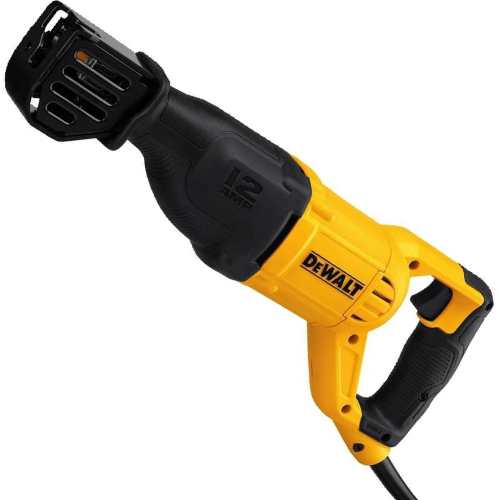
Specifications:
Stroke Speed: 2,900 SPM, Stroke Length: 1-1/8 inch, Motor: 12 Amp, Power Source: Corded Electric.
If you need a corded reciprocating saw, the Dewalt DWE305 is one of the most budget friendly and trusted option you can go for. It’s got all the features you need.
It comes equipped with a powerful 12 amp motor for heavy duty tasks.
The stroke speed is variable from 0 to 2900 SPM and it has a good stroke length of 1-1/8 inches for faster cuts.
Changing blades is very easy because you don’t need any tool to do it. It features a keyless lever-action blade clamp.
The variable speed puts you in control, allowing you to vary your speed to match the job as you cut through different materials with it.
Overall, if you need a good corded reciprocating saw from a trusted brand with all the good features any reciprocating saw can have, then this Dewalt DWE305 is the one you need.
| Pros | Cons |
|---|---|
| It’s very powerful. | It doesn’t come with blades. |
| It’s corded, so there’s no battery that will rundown. It’s Very reliable. | |
| Super easy to change the blade. |
Related: The 10 Best Circular Saws for Woodworking
2. Makita JR3050T Reciprocating Saw
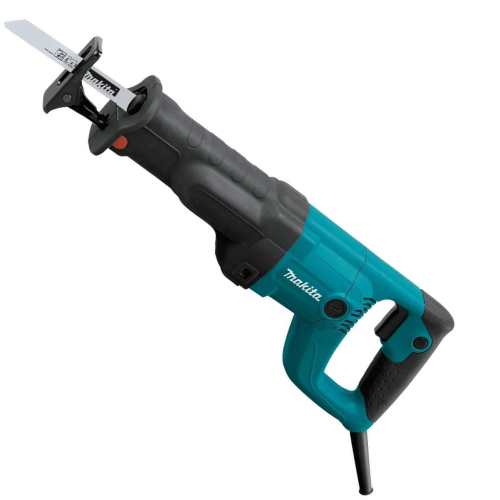
Specifications:
Stroke Speed: 2,800 SPM, Stroke Length: 1-1/8 inch, Motor: 11 Amp, Power Source: Corded Electric.
Makita’s JR3050T corded reciprocating saw is a very versatile and user friendly saw you can use for both heavy duty jobsite projects and DIY projects at home.
Equipped with an 11 amp motor, it has all the power you need to make difficult projects look easy.
It saws fast and smooth with a variable stroke speed of 0 to 2800 SPM and a stroke length of 1-1/8 inches.
A two finger variable speed trigger allows you to control and vary the stroke speed to match the application.
Makita designed the saw so that it weighs only 7.3 lbs, making it easy to use for a long time, especially for overhead cutting operations without causing too much fatigue.
Finally, the saw comes equipped with a built in dust blower to clear the line of cut from debris and dust created during cuts, for a better line of sight and increased accuracy.
| Pros | Cons |
|---|---|
| It comes with a protective carrying case. | The blades that comes with it are thin. You can get Bosch blades instead, to replace them. |
| Doesn’t lack power. | |
| It looks and feels well-built. |
Related: The Dremel Ultra Saw Review
3. Milwaukee 2720-21 M18 Fuel Cordless Sawzall Kit – Best Cordless
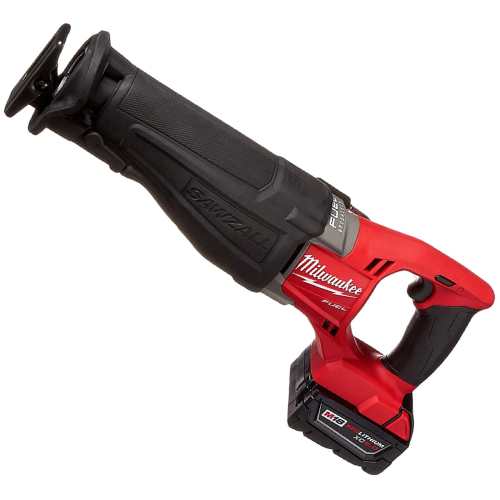
Specifications:
Stroke Speed: 3000 SPM, Stroke Length: 1-1/8 inch, Battery: 18V, Power Source: Cordless.
Milwaukee first introduced the Sawzall or reciprocating saw as we all know, and thus it’s not surprising that they still produce some of the best ones in the market today.
It’s a cordless sawzall and it comes equipped with a brushless motor for better power, efficiency and a longer tool life.
The saw is powered by Milwaukee’s tried and trusted M18 feul batteries, the M18 REDLITHIUM XC 4.0 Extended Capacity Battery Pack.
With this battery, you get 2X more runtime and 30 percent faster cutting than other models.
The 2720-21 M18 Fuel saw features Milwaukee’s redlink plus intelligence system which optimizes the saws performance and provides overload, overheating and over-discharging protection.
It comes equipped with a bright LED light which illuminates your work when it’s getting dark. It has a stroke length of 1-1/8 inches and a stroke speed range of 0-3000, which is good for quickly cutting through materials.
| Pros | Cons |
|---|---|
| Very powerful and efficient. | It doesn’t come with blades |
| The battery lasts for quite some time. | |
| It’s very portable since it’s cordless. |
Related: 10 Best Compound Miter Saws In 2022
4. SKIL SPT44A-00 Buzzkill – Value Pick
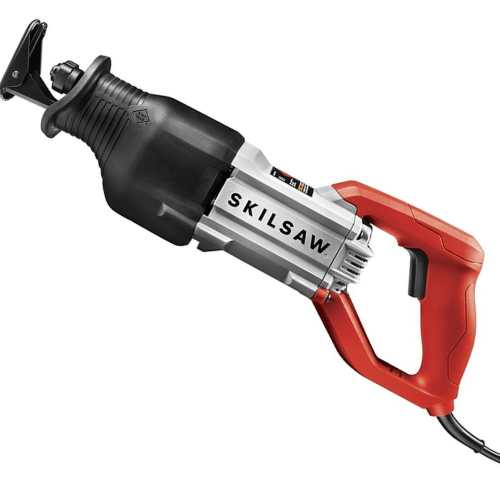
Specifications:
Stroke Speed: 2800 SPM, Stroke Length: 1 inch, Motor: 13 Amp, Power Source: Corded Electric.
One feature you should look for when getting a reciprocating saw is vibration control, and with SKILSAW’s patented Buzzkill tech included in the SPT44A-00, you get one with the best in class in-line vibration suppression.
The Skilsaw Buzzkill comes equipped with a 13 amp motor which produces a max stroke speed of 2800 SPM with a stroke length of 1-1/8 inches, allowing you to cut quickly through even the toughest materials you have at your disposal.
Equipped with a variable speed trigger, you have the ability to adjust the speed according to the material you’re cutting.
Whatever your reason for needing a reciprocating saw is, this Skilsaw SPT44A-00 is ideal for various applications.
You can use it to cut different types of materials including structural steel, cast iron, engineered wood, drywall, non-ferrous metal, plastics and heavy duty pipes.
Just remember to match the application with the right type of blade.
| Pros | Cons |
|---|---|
| Quality build, looks very durable. | It weighs about 9 lb. which is quite heavy. |
| Very powerful. | |
| It doesn’t vibrate a lot like similar units. |
Related: Which Bandsaw Size Should You Choose For Woodworking?
5. Craftsman CMCS300M1 – Best for Small Projects
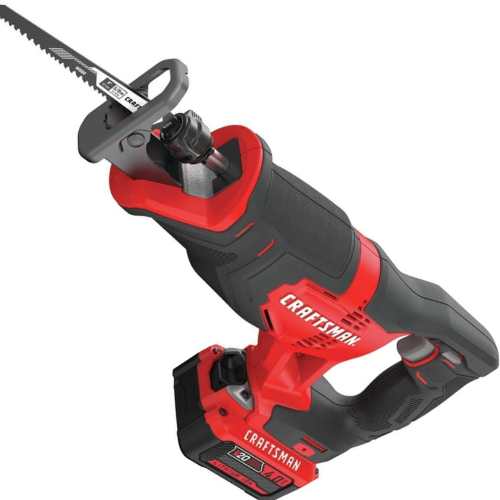
Specifications:
Stroke Speed: 3000 SPM, Stroke Length: 1 inch, Battery: 20 Volts, Power Source: Cordless.
Talking about cordless reciprocating saws, this Craftsman CMCS300M1 is one of the toughest and most reliable ones I’d recommend to tackle simple construction or demolition work, whether in the workshop or on the jobsite.
With it, you can cut through wood, nail-embedded wood, screws, epoxy materials, both PVC and metal pipes, and even rebars.
This will be suitable for plumbers, framers or builders, DIYers, electricians, who need a portable reciprocating saw to tackle simple projects here and there, without dependence on the availability of a power outlet.
Performance / Features:
The Craftsman CMCS300M1 has a stroke length of 1 inch, and produces a maximum speed of 3000 RPM, allowing it to power through cuts with ease.
It’s very compact in size, with a total length of 14.5 inches, making it suitable for making cuts in tight spaces.
It features a variable speed trigger, allowing the user to match the speed of the blade to the material being cut.
A tool-free blade release clamp makes it very easy and simple to swap out old blades with new ones. To change the blade, just twist the spring clamp at the front which reveals a little slot for the blade to be inserted. Insert it and let go to secure the blade.
It comes equipped with a 20V Max 4Ah Lithium Ion battery, which takes at least 45 or more minutes to charge depending on how drained it is. How long the battery lasts will depend on the amount of use it gets.
Handling it is easy and comfortable because it features a contoured over-molded handle, both for the main handle and the auxiliary handle close to the blade.
| Pros | Cons |
|---|---|
| It’s very compact. | It’s not the most powerful reciprocating saw you’ll find. |
| It comes with a 4 Ah battery which provides ample runtime to use the tool for small projects. | |
| It has decent power. |
Related: The 10 Best Plunge-Cut Track Saws For Woodworking
6. WORKPRO 12V Cordless Reciprocating Saw – Best for Pruning Trees

Specifications:
Stroke Speed: 2900 SPM, Stroke Length: 1 inch, Battery: 12 Volts, Power Source: Cordless.
If you want a portable cordless reciprocating saw you can use for making cuts during your projects, this one from WORKPRO is a very good option.
This however is not one of the most powerful you can go for. This is for moderate or medium-duty tasks such as pruning thick tree branches, cutting wood, thin pieces of metal like small bolts and so on.
Performance / Features
With a blade length of 13 inches and a stroke speed of 2900 strokes per minute, The WORKPRO 12 cordless reciprocating saw makes it easy to carry out simple cuts through materials.
It includes a variable speed trigger allowing the user to vary the speed of the blade to suit the material.
Apart from that, changing the blade is very easy, because it features a tool-free blade release chuck that makes it easy to change the blade without using a wrench, and thus reducing downtime.
It comes with 3 saw blades, 2 for wood cutting and 1 for cutting metal.
For safety, the trigger button needs to be pressed down to continue sawing.
Build Quality
With only 13 inches in total length, the WORKPRO is one of the most lightweight and compact reciprocating saws available.
Being so lightweight and compact, it’s ideal for cutting objects in tight or hard to reach spaces. The pistol grip handle and lightweight nature makes it very easy to hold and control for long periods without experiencing fatigue.
Included is a clamping jaw for hooking to round or square materials, preventing the saw blade from vibrating about or changing positions until the cut is complete. Hence, making it easier for less inexperienced users to handle it.
Battery Capacity
The WORKPRO features a 2.0Ah lithium-ion battery that takes just one hour to charge fully. When fully charged, it lasts between 15 to 20 minutes of consistent use.
| Pros | Cons |
|---|---|
| Compact and lightweight. | Battery doesn’t last long. You might need a spare. |
| It comes with battery and charger. | |
| It’s very good for pruning trees. |
7. Ryobi P515

Specifications:
Stroke Speed: 3100 SPM, Stroke Length: 7/8 inch, Battery: 18 Volts, Power Source: Cordless.
If you love Ryobi ONE+ tools, then you’d be happy to add this to your collection. It’s the Ryobi P515 cordless reciprocating saw.
You can power it with most of the Ryobi batteries such as the P100, P101, P102, P103, P104 and so on, some of them you probably already have.
Just, unlash the front of the tool and you can simply pull out the blade. Hence, changing blades takes little to no time.
The P515 Ryobi reciprocating saw has a stroke length of 7/8 inches and a variable stroke speed from 0 to 3100 SPM.
It comes equipped with a variable speed trigger you can use to vary the speed by increasing or reducing the pressure of your fingers on the trigger.
An anti-vibration handle provides comfort and ensures precision as you make cuts with the saw.
All in all, the Ryobi P515 certainly counts among the best reciprocating saws you can use for demolition, renovation, gardening and landscaping.
You can use it to cut wood, prune trees, drywall, pipes, and even iron rods. If you need a powerful but compact model you can use for your projects, the P515 is definitely one of your best bet.
| Pros | Cons |
|---|---|
| Lightweight. | Battery and charger not included. Tool only. |
| It’s very compact. | |
| Low vibration. |

